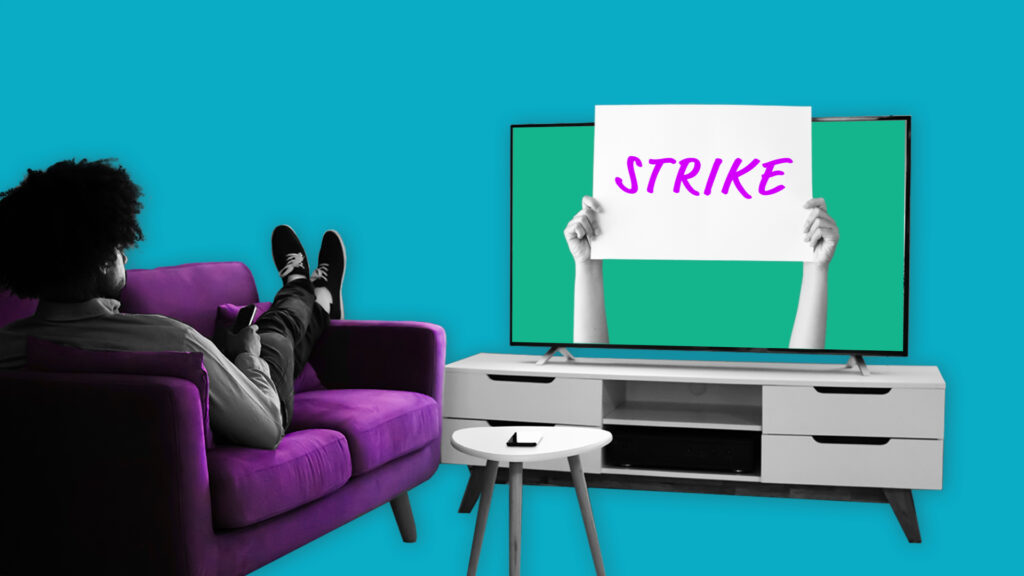The Future of (C)TV Is Now
by Jaci Schreckengost
4 Min Read
The WAG and SAG-AFTRA strikes are sending shock waves through the television and film industry, but they could also impact the state of TV viewership and advertising.

4 Min Read
Picture this… It’s a quiet night at home. After ordering your favorite delivery, you cozy up on your couch and turn on the TV. For a few minutes (or closer to an hour, TBH) you contemplate a variety of new titles before settling on re-watching your comfort show for the hundredth time.
Between traditional television and Connected TV (CTV) there is a seemingly never-ending amount of content to watch—a perk for viewers and advertisers alike. But unrest in Hollywood is shaking things up. The recent strikes may have lasting impacts on the industry, and not just for union members and production studios—ripple effects could influence how and where people choose to consume content and thus where advertisers decide to spend.
Unless you’ve been living under a rock, you’ve, at the very least, heard about the Writers’ Guild of America (WGA) strike that started in early May of this year. There are multiple facets to the “why” behind the strike, but some of the main issues are centered around: pay, the structure of writing rooms, and the use of AI in the industry.
“This year, negotiations began on March 20 and included a series of proposals touching on the changing nature of the industry, which has been transformed in recent years in large part due to the proliferation of streaming platforms,” CNBC explained. “Proposals include new terms around how feature film writers get paid; how many writers can be staffed on TV shows and how long [they’ll] be staffed; the lack of minimums for comedy/variety shows (like late night programs) on streaming; and the regulation of AI in creating new material.”
Last week, after two-plus months of the WGA strike, the Screen Actors Guild-American Federation of Television and Radio Artists (SAG-AFTRA) joined the picket line. While it’s not unheard of for both unions to halt work concurrently, it is uncommon—the last time this occurred was in 1960.
Led by union president Fran Drescher—star of the beloved 90’s sitcom, “The Nanny”—SAG-AFTRA voiced similar concerns to WGA.
“You cannot change the business model as much as it has changed and not expect the contract to change too,” Drescher said in a speech announcing the actors’ strike on July 13. “We are not going to keep doing incremental changes on a contract that no longer honors what is happening right now with this business model that was foisted upon us.”
In solidarity with the unions, people outside of the industry may be looking for ways to support the strike. And while boycotting going to the movies to see “Barbie” or “Oppenheimer”, or canceling streaming subscriptions may seem like an effective way to do so, strikers are encouraging the opposite. Members of WGA and SAG-AFTRA are actually asking people to stick to their typical television and movie watching behaviors.
“A reminder SAG has not called for a consumer boycott,” actor and producer Kylie Sparks wrote in a now widely-shared tweet. “Please keep watching TV and films-if anything, this helps PROVE the studios need us.”
Strikers hope that continued consumer demand for content (old and new) will highlight the importance of the work done by union members. In turn, bolstering arguments for better pay and what they see as fairer contracts.
As people cut cords in increasing numbers, Connected TV continues to lead the charge on media consumption. Even major players in the linear space are acknowledging traditional television’s waning popularity and perceived usefulness. Bob Iger, CEO of Disney, has gone so far as to consider selling the company’s broadcast networks.
“There clearly is content that they [broadcast networks like ESPN and ABC] create that is core to Disney,” Iger told CNBC. “but the distribution model, the business model that forms the underpinning of that business — and that is delivering great profits over the years — is definitely broken, and we have to call it like it is.”
So, what does this have to do with the WGA and SAG-AFTRA strikes? With no end to the strikes in sight, resulting in no new content in the works, the fall broadcast television lineup—which is typically a very fruitful time for advertisers—is likely to underperform this year. Because of this, advertisers may feel inclined to limit their upfront spend on broadcast networks, instead choosing to put more budget into streaming services with deep content catalogs. CTV can act as a refuge for advertisers who still want to reach their audience on television screens.
“Connected TV loyalists will still tune in to their favorite shows and watch when and where they watch in the moment—content aside,” Britt Augenfeld, VP of Advanced TV and Video at Captify, told Marketing Dive. “Network television unfortunately doesn’t have the same luxury.”
Other CTV News You Need to Know: